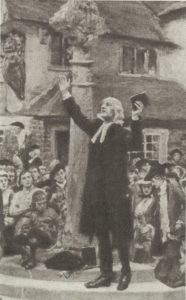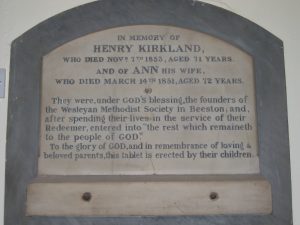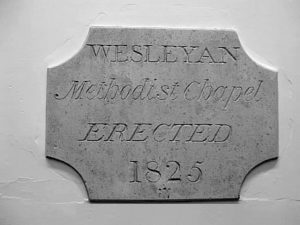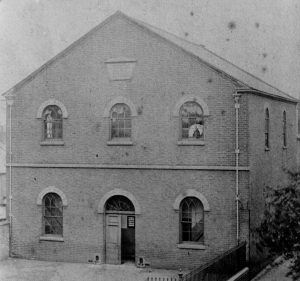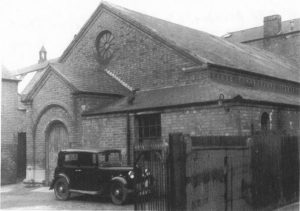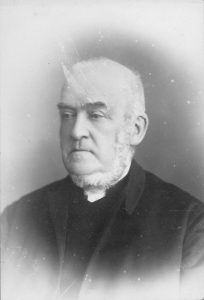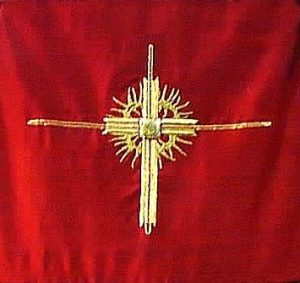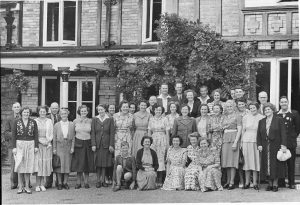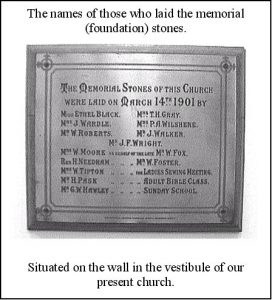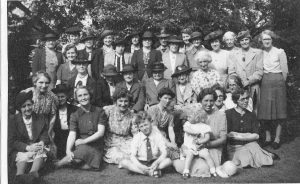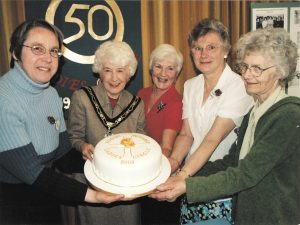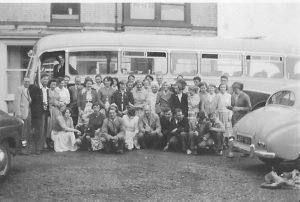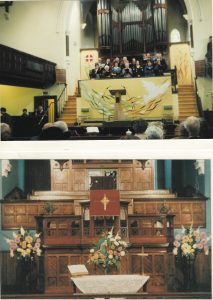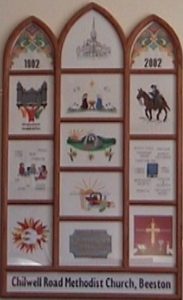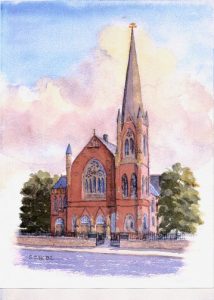1798 Methodists from Chilwell arrived in Beeston and preached in the streets. Eventually a small group formed which met in a barn off Middle Street.
1805 The first Methodist chapel built nearby.
1819 Henry Kirkland Starts the First Wesleyan Methodist Society.
Henry Kirkland, a lace manufacturer and Wesleyan Methodist local preacher, from Radford, came to live in Beeston with his wife, Ann. He formed a Wesleyan Methodist group which was able to take over the small chapel.
Both Henry, as a class-leader and local preacher, and Ann, in charge of the junior class, were influential in bearing their Christian witness in the village of Beeston for many years.
After the deaths of Henry and Ann Kirkland this memorial tablet was placed in the old chapel.
It is now (in 2002) set in the wall of the vestibule of our present church.
1825 The Building of the First Wesleyan Methodist Chapel.
Increased numbers enabled the group to build a larger Wesleyan Methodist Chapel for 300 people further down Chapel Street.
The date-stone from this building is set in the wall of the vestibule of our present church.
1826 Foundation of the Benevolent Society.
Members of the Chapel Street congregation were concerned at the acute poverty in Beeston which was due to the decline of the framework knitting industry. The Benevolent Society was formed, and members pledged a penny or two pence per week to support the poor and sick for whom there was no state benefit. This society still exists today.
1830 The Building of the Second Wesleyan Methodist Chapel.
Further growth meant that yet another chapel, this time for 450 people, was built on the same site.
1839 Foundation of the Day School.
A large Sunday School had developed from the outset alongside the adult church, but in 1839 a Day School was also established on the premises.
1866 Building of the Wesleyan Day School.
In this year a larger, separate building called the Wesleyan Day School was erected. It provided education and a Christian influence in Beeston for many years.
The building is shown here prior to its demolition in the 1930s.
1870s Appointment of First Minister.
From about 1870 onwards the Wesleyan Conference appointed supernumerary ministers to be in charge of the Beeston Church and to live in the district.
The only one of these for whom we have a photographic record is the Rev John Rossell, who was appointed in 1890 at the age of 80 and served until his death in 1893.
For later ministers, including photographs, see the List of Ministers.
1870s Foundation of the Carol Choir.
In the 1870s a group of young men from the chapel choir decided to raise money for the Benevolent Society by singing old carols around Beeston and Chilwell at Christmas. It continued as a male voice choir until the First World War when women joined, many of the men being away fighting. The choir is still going strong and provides the Benevolent Society with its main source of income.
The Carol Choir in 1998 following the publication of “Brightest and Best”; a history of the Choir and Benevolent Society and transcriptions of some of the carols.
1880s
When the Humber Cycle Company established its headquarters in Beeston in the 1880s on what would become Humber Road, the Chapel Street Society quickly founded a mission in that area. This resulted ultimately in the building of the Queens Road Chapel and the establishing of a new Society there.
1891 Ladies Sewing Meeting Founded.
The Ladies Sewing Meeting ran from its inception in 1891 until 1981 and was a very active part of the church throughout. The ladies produced many fine items and raised considerable sums of money towards various projects.
This picture shows the pulpit fall from the Chilwell Road premises prior to the Target 2000 alterations.
1897 The Wesley Guild Founded.
Formed in 1897, the same year as the national Wesley Guild, our own Guild has been meeting ever since. It currently (in 2002) meets every Tuesday evening with a varied programme based on Devotion, Christian Service and Culture. The Guild Festival takes place annually at the beginning of February and typically features a Saturday concert, special services on the Sunday and a celebration dinner at the Tuesday meeting.
This photograph shows an “away-day” in the late 1940s.
1902 The Building of Chilwell Road
By the 1890s it was recognised that a more prominent site and a newer, larger building was needed to meet the needs of the then-growing church. Fund-raising started in 1895. In 1897 a site was purchased on Chilwell Road and in 1899 a design chosen from several that were submitted.
Building commenced and “The Memorial (Foundation) Stones” were laid on March 14th 1901.
1902 The Opening of Chilwell Road
The opening ceremony took place on the 29th May 1902. The fine 3-manual organ, donated by William Roberts was completed a few months later and dedicated in December 1902.
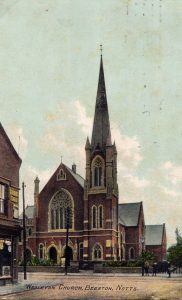 The church had seating for up to 750 people at that time, and is still the tallest building in Beeston by virtue of its impressive spire. The school room and accompanying vestries were of single story construction, but built in the same style as the sanctuary. Adult church membership at the time numbered about 200 (similar to today (in 2002)) and the Sunday School had approaching 300 members (considerably more than today!).
The church had seating for up to 750 people at that time, and is still the tallest building in Beeston by virtue of its impressive spire. The school room and accompanying vestries were of single story construction, but built in the same style as the sanctuary. Adult church membership at the time numbered about 200 (similar to today (in 2002)) and the Sunday School had approaching 300 members (considerably more than today!).
The total cost of the project was £9,000 and it was not until 1919 that the final debt was cleared.
An electricity supply and electric lighting were not installed until 1923 (the 21st Anniversary), and it is interesting to note that the bellows to the organ were operated manually until then.
1931 Women’s Fellowship Founded
This meeting originated in 1931 as the “Women’s Bright Hour” before becoming the “Women’s Meeting” and eventually the “Women’s Fellowship”.
At its peak during the 1950s it had about 40 members. Today (in 2002) there are fewer, but still meets regularly on Monday afternoons for Christian fellowship.
1953 Ladies Circle Founded
Starting as the “Young Mothers’ Fellowship” in 1953, it met on Thursday afternoons. It eventually moved to Thursday evenings, and the name evolved through “Young Wives” and “Wives” before settling on its present (in 2002) name the “Ladies Circle”. Meetings ended in 2021.
The weekly fellowship had a full programme of topics and speakers, and over the years took an active role in many church projects.
1957 Youth Club Founded
Formed in 1957 by Mr Les Williams it quickly became very popular with up to 100 youngsters attending. Many were also members of the Youth Church and attended evening services.
Social events were arranged for Friday evenings, and days out were also organised.
In 1969 five members broke the world record for continuous badminton by playing non-stop for over 120 hours to raise money for Christian Aid.
Declining membership led to closure in the mid-1970s.
1970 Nottingham University Students Linked to Chilwell Road
In 1970 the Methodist Conference decided to appoint a full-time Methodist Chaplain to the University of Nottingham. The first Chaplain was the Rev. Stuart Burgess, who was already attached to Chilwell Road, and the Methsoc students worshipped with us as their “University Church”. The students made a valued contribution to our church life and worship until the Chaplain’s manse was relocated to Lenton in 1998. Several ex-Methsoc members have stayed in the area after graduation and are now (in 2002) active church members.
1987 Friendship Group Founded
In March 1987, several church members visited Bingham Methodist Church, were impressed by the “Bingham Couples Club” and soon started a similar organisation at Chilwell Road. In order to embrace people who were not “in a couple” it was named the “Friendship Group”, and meets monthly on the second Saturday evening. It has proved to be both popular and successful. The Group has introduced new church members, and contributed wholeheartedly to various church projects. The present coffee bar is their special gift, in memory of one of their founders, the late Ron Bexon.
1990s Target 2000
During the 1990s the church conducted an in-depth review, entitled “Think-tank 2000”, to consider our church’s role in the next millennium. To make the premises better suited to modern worship and community use an ambitious redevelopment project was planned (called “Target 2000” because the aim was for everything to be completed before the start of the new millennium). Many improvements to the general facilities and the worship areas in the church were planned.
Building work commenced after Easter 1998 and was completed just before Christmas the same year. In March 1999 the church was full for a re-dedication service, and the fund raising was completed by the end of 1999.
After
Before
2002 100 Years at Chilwell Road
Many celebrations greeted Chilwell Road’s centenary in 2002. One of the most striking creations was the Centenary Cross-stitch. The panels depict various aspects of the church’s life and history.
The Centenary Cross-Stitch (Situated on the south wall of the west transept of our church)
Watercolour painting of the church done especially for the cover of the Centenary Booklet “Seeking to Serve” by Stephen C Wallwork in 2002.
The original is hanging in the church sanctuary.
The material for the history above has been taken from the booklet “Seeking to Serve”, by Margaret Cooper, and published to celebrate the centenary of the church in 2002.
2014, 2016 & 2019 Beeston Methodist Church
Beeston Methodist Church became one church from 1st September 2014, bringing together the people, commitment, energies and resources of Chilwell Road, Clarke’s Lane, Inham Nook, Queen’s Road and Wollaton Road Methodist Churches. The church started worshipping together for all services from Easter Sunday 27th March 2016.
Beeston Methodist Church united at the Chilwell Road building for all services from Aldersgate Sunday 26th May 2019.
Further Information
See the List of Ministers of Chilwell Road Methodist Church, including photographs, and the History of Beeston Methodist Church.

